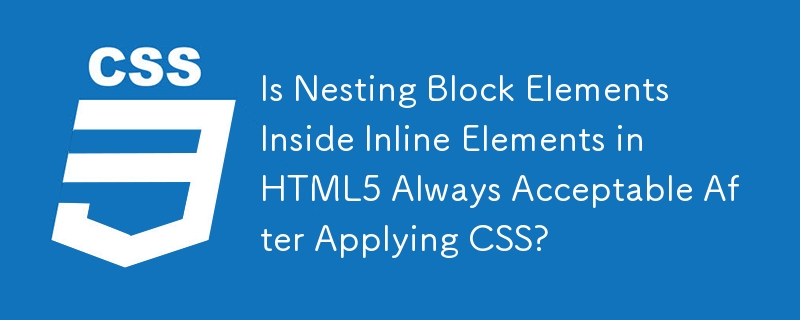 Web Front-end
Web Front-end
 CSS Tutorial
CSS Tutorial
 Is Nesting Block Elements Inside Inline Elements in HTML5 Always Acceptable After Applying CSS?
Is Nesting Block Elements Inside Inline Elements in HTML5 Always Acceptable After Applying CSS?
Is Nesting Block Elements Inside Inline Elements in HTML5 Always Acceptable After Applying CSS?

Breaking the CSS Rule: Inline Elements Containing Block Elements
Traditionally, nesting block elements within inline elements was considered a violation of HTML structure. However, in HTML5, this practice becomes permissible. Does this mean it is acceptable to convert a block element to inline even if it encloses another block element?
The CSS Specification's View
According to the CSS 2.1 Specification, when an inline element contains a block-level element, the inline element splits into two separate boxes, enclosing the block element and its consecutive block-level siblings. These resulting anonymous block boxes become siblings to the original inline element.
Example:
Consider the following HTML markup and CSS rules:
1 |
|
1 2 3 |
|
In this scenario, the div becomes inline, while the p element remains block-level by default. According to CSS 2.1, this results in the div being broken into two anonymous block boxes around the p element.
Browser Implementation and Validity
The CSS specification provides guidance on browser behavior, but implementation consistency and interpretation among modern browsers may vary. Whether or not such nesting is considered valid or not after applying CSS rules depends on the particular browser and its implementation.
Conclusion
While HTML5 allows nesting block elements within inline elements, converting a block element to inline when it already contains a block element presents a gray area. The behavior is technically specified in CSS but subject to browser interpretation and implementation. It's crucial to consider browser compatibility and the intended behavior of your web application before employing this practice.
The above is the detailed content of Is Nesting Block Elements Inside Inline Elements in HTML5 Always Acceptable After Applying CSS?. For more information, please follow other related articles on the PHP Chinese website!

Hot AI Tools

Undresser.AI Undress
AI-powered app for creating realistic nude photos

AI Clothes Remover
Online AI tool for removing clothes from photos.

Undress AI Tool
Undress images for free

Clothoff.io
AI clothes remover

Video Face Swap
Swap faces in any video effortlessly with our completely free AI face swap tool!

Hot Article

Hot Tools

Notepad++7.3.1
Easy-to-use and free code editor

SublimeText3 Chinese version
Chinese version, very easy to use

Zend Studio 13.0.1
Powerful PHP integrated development environment

Dreamweaver CS6
Visual web development tools

SublimeText3 Mac version
God-level code editing software (SublimeText3)

Hot Topics
 1662
1662
 14
14
 1419
1419
 52
52
 1313
1313
 25
25
 1262
1262
 29
29
 1235
1235
 24
24
 Google Fonts Variable Fonts
Apr 09, 2025 am 10:42 AM
Google Fonts Variable Fonts
Apr 09, 2025 am 10:42 AM
I see Google Fonts rolled out a new design (Tweet). Compared to the last big redesign, this feels much more iterative. I can barely tell the difference
 How to Create an Animated Countdown Timer With HTML, CSS and JavaScript
Apr 11, 2025 am 11:29 AM
How to Create an Animated Countdown Timer With HTML, CSS and JavaScript
Apr 11, 2025 am 11:29 AM
Have you ever needed a countdown timer on a project? For something like that, it might be natural to reach for a plugin, but it’s actually a lot more
 HTML Data Attributes Guide
Apr 11, 2025 am 11:50 AM
HTML Data Attributes Guide
Apr 11, 2025 am 11:50 AM
Everything you ever wanted to know about data attributes in HTML, CSS, and JavaScript.
 How We Created a Static Site That Generates Tartan Patterns in SVG
Apr 09, 2025 am 11:29 AM
How We Created a Static Site That Generates Tartan Patterns in SVG
Apr 09, 2025 am 11:29 AM
Tartan is a patterned cloth that’s typically associated with Scotland, particularly their fashionable kilts. On tartanify.com, we gathered over 5,000 tartan
 A Proof of Concept for Making Sass Faster
Apr 16, 2025 am 10:38 AM
A Proof of Concept for Making Sass Faster
Apr 16, 2025 am 10:38 AM
At the start of a new project, Sass compilation happens in the blink of an eye. This feels great, especially when it’s paired with Browsersync, which reloads
 How to Build Vue Components in a WordPress Theme
Apr 11, 2025 am 11:03 AM
How to Build Vue Components in a WordPress Theme
Apr 11, 2025 am 11:03 AM
The inline-template directive allows us to build rich Vue components as a progressive enhancement over existing WordPress markup.
 PHP is A-OK for Templating
Apr 11, 2025 am 11:04 AM
PHP is A-OK for Templating
Apr 11, 2025 am 11:04 AM
PHP templating often gets a bad rap for facilitating subpar code — but that doesn't have to be the case. Let’s look at how PHP projects can enforce a basic
 Programming Sass to Create Accessible Color Combinations
Apr 09, 2025 am 11:30 AM
Programming Sass to Create Accessible Color Combinations
Apr 09, 2025 am 11:30 AM
We are always looking to make the web more accessible. Color contrast is just math, so Sass can help cover edge cases that designers might have missed.



